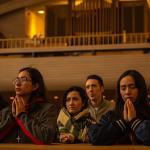Christian liturgical practices have remained constant as much as they have changed. As early as the first century, we have a ‘manual’ of sorts, the Didache, which teaches Christians how to perform basic Christian rites and practices such as the eucharist, baptism, fasting, prayer, and ordination. Importantly, these practices not only take on a unique importance in different periods, but also take on unique forms. For instance, the way in which one should be baptized is discussed in the Didache: “baptize in the name of the Father and of the Son and the Holy Spirit in running water. But if you have no running water, then baptize in some other water… But if you have neither, then pour water on the head three times in the name of Father and Son and Holy Spirit” (Didache 7.1-3). In other words, the author of the Didache lays out a preferred mode of baptism, namely immersion in running water, but that is ultimately secondary to the invocation of the triune names of God and other preparations such as fasting.
The proper mode and theology of Christian practices such as baptism, of course, are still a live discussion in and between denominations. Do we baptize by immersion or sprinkling? Do we baptize infants or those of declared faith? What exactly is happening in this physical act? Paying close attention to how Christians from the past considered these rites is often instructive (see Alex Fogelman’s post on baptism and his new book), particularly in demonstrating the wide variety of understandings which do not conform to modern conversations. This variety, of course, should not necessarily prevent theological or practical convictions concerning baptism or other liturgical practices, but it has encouraged something in my own reflection—we need to be mindful of our embodied experience, contemplating the ways in which we participate in the grace of God in these acts. In my own life, a baptismal rite from the fourth century has been a great catalyst for this type of devotional and theological reflection: Catechumens were baptized naked.
Converting to Christianity in Ancient Jerusalem
While we have catechetical discourses from several early church writers (such as Ambrose of Milan, John Chrysostom, Theodore of Mopsuestia, and Gregory of Nyssa), we have a particularly fascinating window into the theology of baptism and the embodied experience of catechumens in fourth century Jerusalem. This is because we have two distinct accounts of this practice in Jerusalem from this period. First, we have lectures on baptism and the eucharist from Cyril, the bishop of Jerusalem from 350 to 386, explaining why certain actions were performed in certain ways (I also wrote on a passage from Cyril last month). Second, there is an account which details practical aspects of catechesis written by Egeria (sometime between 381 and 384), a pilgrim from western Europe who wrote of her experience in the Holy Land for a group of women back home.
To understand the experience of these Christian converts, we must first start at the beginning of Lent, which was observed for eight weeks. Egeria explains how catechumens sat before the bishop for three hours most days of Lent and are taught through the arch of Scriptures: “beginning with Genesis he goes through the whole of Scripture during these forty days, expounding first its literal meaning and then explaining the spiritual meaning.” After this, they repeat this process with the Creed: “He explains the meaning of each of the phrases of the Creed in the same way he explained Holy Scripture…” (Egeria, Diary of a Pilgrim, 46). What an intensive introduction into the mysteries of the Christian faith!
Throughout passion week, there is a break from daily instruction leading up to Easter morning, when the Catechumens are baptized. Cyril explains the baptismal process in his mystagogical lectures: 1) the converts strip off their clothes; 2) they are anointed with oil to exorcise demons; 3) they profess their belief in the Father, Son, and Holy Spirit; 4) they are immersed in the baptismal pool three times; 5) they emerge from the pool and are clothed with white robes. There are significant continuities and discontinuities between the rites explicated in the Didache and those in Jerusalem in the fourth century, or at least nuances in how the act is performed. While the Didache requests a single immersion in running water, for instance, Cyril details a triple immersion in a pool. The most striking discontinuity though, is the nakedness of the catechumens, which appears to be a relatively common in the practice of the early church—why was this the case?

Participating in Christ’s Bodily Crucifixion and Resurrection
Cyril details the theological motivation at play in baptism, the reason for this nakedness: Catechumens participate in Christ’s death and resurrection. He writes,
Immediately, then, having entered, you stripped off your clothing. And this was an image of “putting off the old man with his deed” (Col 3.9). Having stripped, you were naked, imitating also by this the nakedness of Christ on the cross, who in his nakedness ‘disarmed the principalities of Christ on the cross, and openly triumphed over them on a tree’ (Col 2.15). (Cyril, Mystagogical Catecheses II.2)
As Christ was put to death naked on a cross, so our old selves are put to death naked. This seems to be drawing from Paul’s discussion of Baptism in Romans 6:3-4, “Or don’t you know that all of us who were baptized into Christ Jesus were baptized into his death? We were therefore buried with him through baptism into death in order that, just as Christ was raised from the dead through the glory of the Father, we too may live a new life.” Of course, this participation not only roots the odd choice in clothing (or lack thereof), but also being immersed three times: “You professed this saving confession and you descended three times into the water and ascended again, thereby also re-enacting through symbol the three-day burial of Christ.” (Cyril, Mystagogical Catecheses II.4) Finally, Christians put on the white robes to represent the resurrected body of Jesus Christ, a body which they will one day put on in the general resurrection.
Cyril summarizes the mystery of our participation in Christ’s death and resurrection, the ground of our salvation:
O strange and incredible thing! We did not really die, we were not really buried, we were not really crucified and raised; our imitation was an image, but our salvation was real. Christ was truly crucified, and buried and raised up, and all these things he graciously gave to us, so that by the imitation of his passion we might gain participation in salvation in reality (Cyril, Mystagogical Catecheses II.5).
Being Mindful of the Body
Baptism is necessarily a physical act—our bodies encounter the waters, in whatever mode of baptism your tradition utilizes. What does this teach us about our bodies, about the grace of God, about what this rite accomplishes? The strength of this fourth century practice of baptism, detailed by Cyril and Egeria, is that is allows us to enter into the salvific act of the cross, burial, and resurrection of Jesus Christ is profound ways. The shame of the cross is felt in naked shame, the watery tomb is experienced in multiple immersions, and the comfort and warmth of those robes laid across the new Christian’s shoulders gives a glimpse into the glory of the resurrected body. There is power in bodily experience, especially as it points us towards the salvation which Christ secured for humanity.
My encouragement here is to be mindful of our embodied practices, but not imitate this fourth century iteration of baptism completely: please do not strip off your clothes at the baptismal font this Sunday! Rather, find ways to engage your body in worship. After all, Christ’s tortured, crucified, dead, and resurrected body is central to our salvation—so too, should our bodies be central in our worship and participation in this glorious reality.

















